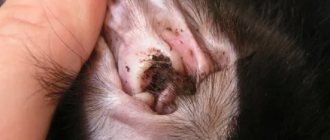If blackness appears in the ears of cats, this indicates poor ear hygiene or is a symptom of ear mites. With otodectosis, the disease has several stages of progression and is accompanied by severe itching, the appearance of crusts, and brown-black discharge. When a cat's ears turn black, the owner should take the pet to a veterinarian, who will diagnose and prescribe treatment.
According to veterinarians, ear parasites affect young cats and kittens whose immune systems are weakened.
Causes of plaque and provoking factors for its accumulation
Let's consider the main reasons for the appearance of plaque and provoking factors
- The natural process of earwax accumulation. This is also typical for cats, and therefore even pets need to clean their ear canals and ears from time to time. The intensity of this phenomenon varies from animal to animal: in some cats, plaque is barely noticeable even after six months, while in other pets, after a month, the ears are heavily clogged with it. The ears of animals with large ears (Sphynxes, Siamese cats, etc.) require especially careful care and attention.
- Symptom of otodectosis, i.e. ear mite. In severe cases, plaque is the least of the problems, since the cat develops severe inflammation in the ear canals, allergic reactions are also possible, especially “lucky” cats die from sepsis or meningitis, provoked by otitis media of parasitic (more precisely, tick-borne) origin. In these same cases, a large amount of foul-smelling, brownish-red exudate often flows from the ear canals of a sick animal. It is the ear mite that in most cases is responsible for the formation of a large amount of brown plaque. Therefore, we would recommend that you do not rush to clean your cat’s ears, but immediately show your pet to a veterinarian. The sooner treatment is started, the greater the chance that severe otodectosis can be avoided.
- Various types of otitis (i.e. inflammation of the ears). Otitis is a very typical complication of the same otodectosis. Primary ear inflammation is extremely uncharacteristic for these animals.
- Fungal and yeast ear infections.
- Long hair and large ears , i.e. The ears of the same Sphynx or Persian cats need special care.
Diagnostic measures
The animal's hearing organs are subject to a thorough examination by a doctor.
To find out why the ear turns black, the veterinarian performs an external examination. A specific crust, scratching and greasy black discharge help in making a diagnosis. To confirm otodectosis, plaque scraping and examination under a microscope are performed. The procedure takes little time, is painless and non-traumatic. An otoscopy is also performed to find out how much the inner ear is affected.
Diseases accompanied by the appearance of brown plaque: list and description
In general, we have already described all the diseases accompanied by the appearance of brown plaque, but in this chapter they need to be considered in more detail.
Otodectosis
The most typical cause of plaque is otodectosis. Otodectes Cynotis mites live in the ear canals of cats. They especially love warmth and dampness. They feed on the epithelium of dead skin, as well as blood and lymph.
The plaque these “guests” leave behind is their feces, as well as the corpses of dead individuals, chitin shed during the growth of young individuals, as well as other waste products. In most cases, infection occurs through direct contact of a cat with sick relatives.
The disease is accompanied by the following symptoms:
- Copious brownish deposits in the ears, increasing in volume at a shocking rate.
- The cat's ears itch unbearably. Soon the ears take on a completely pathetic and indecent appearance, being torn almost to shreds.
- Due to the inflammatory reaction in the ear canals, the exudate mentioned above begins to be released from them.
Very often, advanced cases of otodectosis are accompanied by purulent otitis (due to the intervention of pathogenic microflora), as well as allergic reactions, the latter sometimes ending in anaphylactic shock.
Otitis
This is what inflammation of the ear is called. And not only the ear canal, as some breeders think. Otitis can occur in the following forms:
- Outer. Only the auricle and adjacent soft tissues are affected.
- Middle (also called medial). The ear canal is affected.
- Interior. The most severe option, associated with inflammation of the inner ear, eardrum, etc. Can lead to death due to sepsis or brain damage.
The accumulation of plaque is accompanied by the first two forms. The internal variety is so severe that the owner has no time for plaque. In addition, in both cases, the appearance of drops of exudate is almost inevitable (almost from the first days of the disease).
Often, otitis media is accompanied by the appearance of an extremely unpleasant odor emanating from the ears of a sick animal. This pathology is a common consequence of advanced otodectosis.
And ear inflammation, by the way, is often provoked not even by the mites themselves, but by an allergic reaction that occurs as a response of the body to the products of their vital activity.
Fungal and yeast ear infections
As a rule, all these pathologies do not arise “just like that.”
They are promoted by the same ear mite. The parasite not only “impairs” the dog’s immunity, but also creates simply excellent living conditions for ticks (i.e., warmth, moisture and fertilizer in the form of dead parasites and their excrement).
Fungi often affect cats that have been forced or unduly treated with powerful antibiotics or anti-inflammatory corticosteroids. If, against the background of this, the cat also suffers from otodectosis, fungus in the ears is almost guaranteed.
A sign of the disease is both heavy plaque and odor. If there is a fungus, the “aroma” from the ears is not at all the same as with purulent otitis media or otodectosis. It’s not even disgusting, as it resembles the smell of mushrooms and cheese. In some cases, notes of something moldy are clearly felt in the smell.
Allergy
Atopic dermatitis
Allergy is a hypersensitive response to an irritant.
Crusts on the ears occur with the following types of allergies:
- Flea dermatitis: the body becomes sensitized to the saliva of the arthropod and with repeated bites a violent reaction develops. In addition to the ears, the inflammatory process with the formation of crusts spreads to the neck, muzzle, and torso.
- Atopic dermatitis is a reaction to external irritants: pollen, smoke, perfume. Dry eczema develops. The pathology is congenital and occurs in predisposed individuals.
- Contact dermatitis - occurs with the same symptoms as atopic dermatitis, but is not congenital and can be treated.
- Food allergy: develops in cats predisposed to an inadequate reaction to any food ingredient. It occurs with signs of dry eczema.
- Reaction to medications: occurs due to individual intolerance. Characterized by skin rashes or swelling.
- Photosensitization - the mechanism of its occurrence has not been sufficiently studied. Endotoxins accumulate in the skin, which, when exposed to sunlight, cause burns reminiscent of those that a person gets on the beach. Short-haired individuals of white color suffer.
Sunburn due to photosensitivity
Allergic manifestations are treated by eliminating the causes.
Depending on the type of allergy, the following remedies are used:
- insecticides;
- anti-inflammatory corticosteroids;
- antihistamines;
- hypoallergenic ready-made food;
- wound healing ointments.
Special cases
There are also special cases that we have already indirectly mentioned above. We are talking about some cat breeds that, as a result of many centuries of selection, have acquired some specific characteristics. In particular, sphinxes have ears that are so “original” that they have no ability for natural self-cleaning at all.
In addition, this breed has another feature: their ears produce particularly large amounts of wax. Normally, it protects the ears from pathogenic and conditionally pathogenic microflora, as well as foreign objects, but sphinxes have too much of it. And therefore, heavy plaque inside the hearing organs is commonplace for such cats.
If plaque is only in one ear
In cases where there is plaque in only one ear, we can talk about:
- Or is it an individual feature of a cat that synthesizes more sulfur in one ear (this happens, and is not so rare).
- Or, what is much more likely, one ear is already affected by a tick, or an inflammatory process of a different etiology has already developed there. You shouldn’t expect miracles: over time (more precisely, very soon), parasites or harmful bacteria will end up in the second ear. Moreover, if we are talking about otodectosis, both ears will still have to be treated.
What does a strong smell from the ears mean?
Nothing good. Normally, cats' ears, although they do not smell lavender, still do not cause gag reflexes.
Therefore, a pungent odor may appear in the following cases:
- Fungal infections (we have already written that the smell is very specific).
- Purulent inflammation.
- Advanced forms of otodectosis.
Treatment of cats with ear pathologies
Considering the variety of ear pathologies and their different etiologies, it is easy to understand that the treatment of a cat will directly depend on the root cause of the disease:
- Let's start with otodectosis, since it occurs in almost every second cat. And, by the way, there are no problems with his treatment either. In any veterinary pharmacy you can find dozens of types of drops. Among them are: Stronghold, “Dana”, “Bars”, Otovedin, Tsipam, Aurikan and many others. As an aid, you can use 3% hydrogen peroxide and a strong infusion of green tea. They are good for cleaning the ears before administering the main medicine.
- As for otitis media, it is more complicated. The ear canal must be cleaned daily with the same peroxide, green tea and/or salicylic alcohol. In severe cases, ear rinsing with antiseptic compounds is also prescribed. Broad-spectrum antibiotics are used to destroy pathogenic microflora. At the moment, it is advisable to use drugs from the group of cephalosporins.
- The worst situation is with fungal pathologies. For their treatment, the following are used: Amphotericin B, Flucytosine, Econazole and Clotrimazole. Special antibiotics from the griseofulvin group have proven themselves to be effective.
Remember! All these remedies, when used for a long time, have a bad effect on the cat’s liver, but they have to be used for a long time. Therefore, various hepatoprotectors are used simultaneously.
Diagnostic methods
The treatment is carried out by a dentist-therapist. Diagnosis begins with an examination and a detailed survey: the doctor will find out what medications you have taken recently, and whether there are any chronic or infectious diseases. A cytological examination of plaque taken from the mucosa is mandatory. This is important because a buildup of non-fungal flora can easily be confused with a fungal infection.
The scraping is performed in the morning, on an empty stomach; there is no need to brush your teeth before the procedure. The day before, it is important to avoid eating foods rich in carbohydrates so as not to provoke the growth of pathogenic flora. Research allows not only to accurately determine the causative agent and type of Candida fungus, but also to find out the sensitivity of fungi to the main antifungal drugs. Based on the test results, the doctor will determine the fungus in the oral cavity and prescribe medication.
Prevention and hygiene of the ears
As for individual characteristics, including the accelerated accumulation of wax in the ear canals, in this case the most important role is played by prevention and hygiene of the ears.
This is done like this:
- It is necessary to examine your pet's ear canals at least once every two weeks.
- If large accumulations of sulfur are found there, they are removed using for this purpose a 3% solution of hydrogen peroxide and/or sterile vegetable oil.
- If a cat begins to constantly scratch its ears, the above-mentioned drops are used as a preventative measure.
Alarming symptoms
If you have come into contact with a chemical or vapor, you should immediately contact a clinic. Otherwise, the condition will only get worse. There is a high probability of internal damage if:
- Severe, persistent pain appeared in the mouth, throat, and along the esophagus.
- When you swallow, the discomfort intensifies, and you can’t even drink the liquid.
- There is vomiting, especially with blood.
- Profuse salivation began.
- It became difficult to breathe.
- The temperature has risen (due to intoxication).
- Swelling of the mucous membrane.
- The victim is either drowsy or, on the contrary, restless.
- Severe burns of external tissues, blisters.











